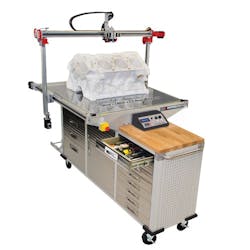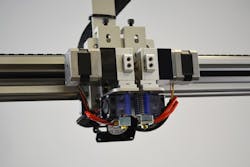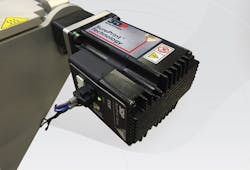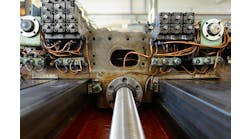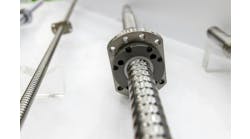The development of an open-air, cost-effective 3D printer platform
Dave Perkon is technical editor for Control Design. He has engineered and managed automation projects for Fortune500 companies in the medical, automotive, semiconductor, defense and solar industries.
"Designing, developing and building a large-format 3D printer, in our case, started due to a project need," states Joseph Binka, additive manufacturing engineer at 3D Platform (3DP) in Roscoe, Illinois. "It also helped that some of the custom industrial 3D-printing solutions cost several hundred thousand dollars. Being a subject matter expert on linear actuators and an R&D engineer, the pieces fell into place to develop a 3D printer."
3D Platform set out to develop the large-format 3D printer based on its more than 30 years of machine design experience with high-performance industrial machines such as laser, waterjet and plasma cutters.
"Printer design was in our wheelhouse," notes Binka. "It definitely helped performance and reliability of the printer to utilize the SIMO Series CRT linear actuators from PBC Linear that I helped to develop."
Birth of a 3D printer platform
Binka started with 3D Platform's parent company, PBC Linear, about 10 years ago. He worked in the linear-motion division, designing new products and creating intellectual property, and he was highly focused on R&D. His last PBC product launch was the SIMO Series line of linear actuators, which are designed to be versatile, having many mix-and–match features and options. These actuators eventually made it to 3D Platform's printers (Figure 1).
Figure 1: The 3DP Workbench is an industrial-strength, large-format 3D printer.
Binka began using 3D printing during development of the SIMO linear actuators to develop a complicated modular motor mount. "I really saw the value of additive manufacturing at this stage of development, as I could iterate my designs quickly," Binka says. "However, the cost of outsourcing these prototype 3D-printed parts quickly started to add up. At that point, I asked PBC Linear's CEO Robert Schroeder if we could buy a 3D printer to be used for engineering prototypes. He said, 'Sure, get a quote.'"
The next day Binka dropped a quote onto his desk that was north of $300,000. Schroeder's response was, “No. You’re an engineer in a linear motion company. Go build one.” That started it all.
Bigger 3D printing
Binka and another engineer worked 50 hours a week on their day jobs and another 40 designing and building the first prototype of the 3D printer. "We built the first machine with a 400-mm build envelope," comments Binka. "We thought it was a massive 3D printer, but, when our CEO saw it, he said, ‘It’s nice, but it needs to be bigger.’” And so began 3D Platform's development and manufacture of large-format, industrial 3D printing machines.
Also read: As machine trends change, motion requirements stay unaffected
It was Schroeder’s vision at this early stage that paved the way for success in large-format polymer printing, says Binka. "It was revolutionary for a startup to break ranks from the desktop market where they were in a race to the bottom," he says. "Being smaller and cheaper was where everyone was headed. This gave us our identity and industrial customers instantly saw value in our size and cost structure."
Figure 2: The extruder is the heart of the 3D printer, and it is what dictates the maximum machine speed.
Moving forward, 3D Platform plans to continue this philosophy and really push the limits of what is possible with a fused filament fabrication (FFF) type 3D printer. Bigger nozzles, higher yield and faster print times will be high on its priority list now and in the future (Figure 2).
The face of 3D printing
Today, 3D Platform has grown to 30 full-time employees and has created a global resell network in the United States and expanded it to reach into Europe, the United Kingdom, China, Israel and India.
Binka works with the engineers and technicians, overseeing all design decisions, product development and improvement. While 3D Platform has an electrical engineer and a programmer/designer on staff, its big focus is in the assembly room with its skilled electrical and mechanical assemblers. They are really the backbone of 3D Platform's machines, ensuring quality builds and machine calibration under the tight deadlines often encountered.
"Our field service technicians and trainers are grown in house, as it is difficult to fill these positions due to the diverse skill requirements such as troubleshooting mechanical, electrical and software issues," notes Binka. "They also need to be very competent on the setup, programming and application of 3D printers. It doesn't just stop at technical skills. Because they are the face of the company, our service technicians need to have great interpersonal skills, as well. The need to be on the road 70% of the time also makes our service technicians a special group."
Large scale
3D Platform decided that low cost of entry and operation were what customers needed, so it based its machine on fused filament 3D printing—a well developed technology. This makes 3D Platform's machine right at home on the shop floor, and it is being integrated into industrial work flows, often with multiple machines.
"We have taken the handcuffs off of our customers—providing an open system—allowing them full access to the machine's firmware, software and hardware," states Binka. "This has allowed some amazing innovation, and customers can customize the machine to fit their specific end uses. Opening things up helps with the fast-changing hardware technology, print management and CAD integration."
Binka and his colleagues come from a background in high-precision industrial positioning systems. "It was critical that we took that experience and created a platform that was solid, square and repeatable," he says. "This machine looks more like a CNC machine than a 3D printer. We knew if we started with a good base, the process would be much easier to control."
The system is completely modular, and the gantry can fold down, allowing this large machine to fit thru a 24-in doorway. The 3D printer has a large work envelope of 1,000 mm by 1,000 mm by 500 mm, much larger than typical desktop printers. The 3D printer can process any material with a melt point of less than 300 °C. Nozzle options range from 0.25 mm up to 1.2 mm. This allows layer resolution from 70 microns up to 840 microns.
"The market is driving rapid advances in 3D-printer motion and process technology,” says Binka. In just the past two years, for example, extruder technology has enabled a sixfold increase in print speed, he notes. One of the reasons 3D Platform focused significant attention on the motion system technology was to improve cycle time and final part quality.
3D mechatronic solution
The printer uses PBC Linear's SIMO CRT Series precision rails and Constant Force anti-backlash lead screws and nuts. Due to the travel length, dual actuators are used for each of the three printer axes.
They provide a low-cost, industrial-grade motion package with high accuracy using PBC Linear's patented Constant Force anti-backlash nut.
The dual xy actuators are specified for high rigidity, quick change of direction and precision using a 25 mm/rev lead screw for high speed at low rpm. The z actuators use 2 mm/rev lead screws for precise positional accuracy. All accessories used on the actuator, such as sensors, motor mounts and carriage-to-carriage mounting plates are off the shelf.
Figure 3: Motors bolted to the linear-motion actuators provide the framework for this 3D printing machine.
PBC Linear's SurePrint servo technology includes NEMA 23 step servo motors and encoder inside a servo control loop to improve overall performance (Figure 3). This motor and control technology takes advantage of the stepper motor’s strong points, creating more than 50% more torque for fast dynamic response and torque control for high operating efficiency. The design provides a rigid, accurate position at zero speed and allows travel speeds up to 200 mm/s. A 20,000-count encoder ensures precise, repeatable positioning that exceeds process capability. This closed-loop stepper technology is available with PBC Linear’s SIMO series actuators, providing a complete mechatronics solution.
3D printing control
When it came to the control system, 3D Platform's philosophy was to keep the design as simple, cost-effective and efficient as possible. "Two of the biggest needs identified during initial development was reliability and cost," notes Ben Williams, a controls designer at 3D Platform. "This is why we selected the ATmega2560 microcontroller, Arduino Mega 2560 board with Ramps 1.4 shield software. It is a good microcontroller platform allowing us to use open-sourced Marlin firmware for 3D printers."
The machine uses the Mega 2560 for I/O control and USB communication. It has everything needed to support the microcontroller and 3D printing application by connecting it to a computer and power supply. The microcontroller is installed in an operator-interface enclosure with small LCD display and three control buttons for simple power on/off control and basic operator functions.
The 3D printers use ball-screw linear actuators with each driven by SurePrint Servo motors. "The microcontroller board sends step and direction signals to the motors," notes Williams. "The SurePrint integrated motors handle all of the electronic gearing, microstepping and closed-loop encoder positioning. The SurePrint motors' internal programs store software tunable parameters to improve settling time and accuracy."
Each actuator uses Hall effect sensors for end stops, and a simple mechanical switch is set up to let the user know when the machine has run out of filament, explains Williams. "If filament runs out, the machine will stop, save its location and move to a home position where the user can easily replace the filament," he says. "With the filament replaced, a press of a button on the microcontroller interface will start printing again right where it left off."
The integrated motors have driven the innovation on the 3D printer, says Williams. "Not only do the motors give 3DP's printer more speed and torque for faster cycle times, they also improve accuracy greatly due to the close-loop control capability," he explains. "The technology used helps to fill a niche in the 3D printing market—an inexpensive, industrial 3D printer. As the 3D industry grows, the costs are coming down, which allows us to incorporate more of the new technologies that we are seeing."
Accessing and safeguarding machinery
The 3DP machine includes basic remote access for troubleshooting. "If a customer is having a problem with the printer, we can have them allow us remote access to the computer for control of the printer," says Williams. "The remote connection allows a technician to easily view the customer's process settings to assist in setting up the print process. It also allows some control functions, and the technician can check on a printer remotely and stop it, if necessary. Additional network compatibility is planned for the future, not only for more print monitoring, but also improved troubleshooting."
A big safety hurdle came up while updating the machine for CE compliance. This required the addition of emergency stopping devices, as well as a warning when the heated bed reached a certain temperature. Downward force applied to the machine in the z axis also needed to be reduced to eliminate a serious point. This was overcome by limiting the amount of current in each of the z-axis motors.
"Based on feedback from our CE certification, limiting torque at the pinch points to 150 Newtons, or less than 34 lb, eliminates the risk of permanent injury,” says Binka. "However, the end user is responsible for safeguarding machines and should consider this need when purchasing any machinery. Our machines are used in many environments where guarding is required. In most cases, extra guarding is installed on site by the end users based on factory requirements."
New types of plastic filaments are frequently introduced in the industry, and, as these filaments are released, they require different process settings and limits based on how well they perform. "Hopefully some of these new filaments will allow us to start printing faster because the equipment is capable of it," notes Williams. "I am always looking for new technology and improvements that will allow 3DP's printer to move more accurately and to complete the moves faster, so we'll be ready when the filament's print speed catches up to our equipment."


